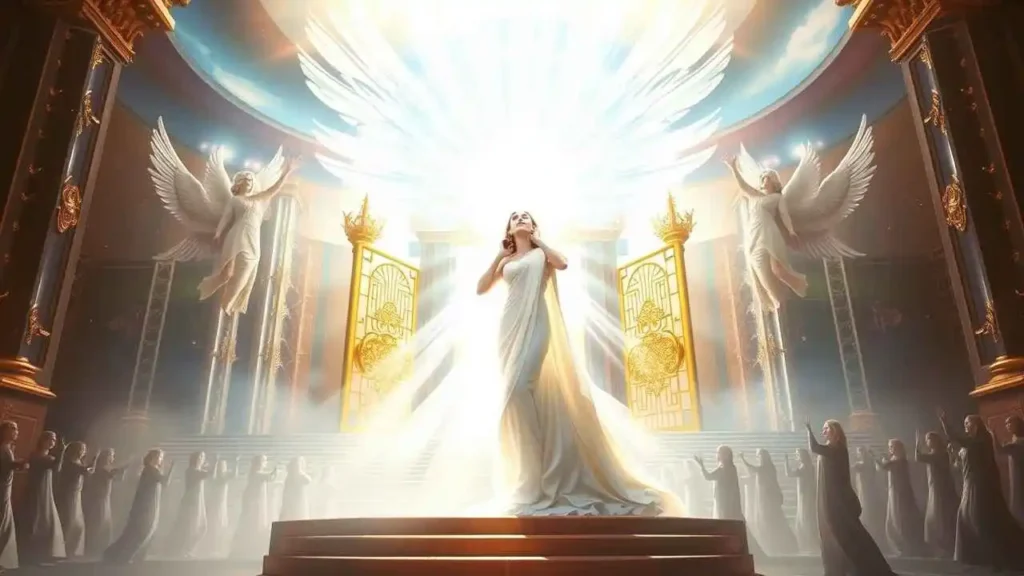
Revelation 21:9–14 – The Bride of the Lamb and the New Jerusalem
The book of Revelation, the final book of the Bible, is rich in symbolism and imagery, often leaving readers both fascinated and perplexed. Among its many powerful symbols, the “Bride of Christ” stands out as a compelling representation of the Church’s ultimate destiny and union with Jesus Christ. This concept is particularly prominent in Revelation 21, where the New Jerusalem is depicted as a bride adorned for her husband. In this article, we will delve into the meaning and significance of the Bride of Christ within the context of Revelation 21, exploring its implications for believers and the Church as a whole.
We will explore the biblical basis for this metaphor, examine the characteristics of the Bride as described in Revelation 21, and discuss the profound implications of this union for the future of the Church and the world. Let’s begin by setting the stage and considering the foundational understanding of the Bride of Christ within scripture.
Understanding the Concept of the Bride of Christ in the Old Testament and New Testament
The concept of the “Bride of Christ” is a profound and cherished theme within Christian theology, symbolizing the intimate and covenantal relationship between Christ and His church. This metaphor is woven throughout both the Old and New Testaments, offering believers a rich tapestry of imagery reflecting God’s divine love, faithfulness, and redemptive plan. As we explore this compelling subject, we will examine its roots in the Old Testament, its fulfillment and expansion in the New Testament, and its enduring significance for Christians today.
“Let us rejoice and be glad and give him glory! For the wedding of the Lamb has come, and his bride has made herself ready.” — Revelation 19:7 (NIV)
The Old Testament Foundations of the Bride of Christ
Though the explicit phrase “Bride of Christ” is not directly mentioned in the Old Testament, the foundation for this concept is laid through various symbolic relationships and prophetic literature. The imagery of marriage, bride, and bridegroom is a recurring motif applied to the covenant relationship between God and His people Israel.
Marriage as a Metaphor for God’s Covenant
In the Old Testament, marriage represents an intimate, exclusive bond, often used as a metaphor for God’s covenant with Israel. Understanding these references helps us grasp the theological roots of the Bride of Christ.
| Old Testament Reference | Description | Significance |
| Isaiah 54:5 | “For your Maker is your husband—the LORD Almighty is his name…” | Illustrates God as the faithful husband to Israel despite her unfaithfulness, underscoring God’s covenant love. |
| Hosea 2:19-20 | “I will betroth you to me forever…” | Highlights God’s steadfast commitment, promising restoration despite Israel’s infidelity. |
| Jeremiah 2:2 | “I remember the devotion of your youth… your bridehood.” | Evokes God’s longing for the faithful, loving relationship with His people. |
| Ezekiel 16:8 | God as a husband who finds Israel in innocence and covenants with her | Symbolizes God’s initiating role in the covenant, with Israel as the cherished bride. |
Israel as the Bride
Throughout the prophets, Israel is depicted as God’s bride—often with poignant emphasis on faithlessness, repentance, and restoration. The metaphor conveys the depth of God’s emotional investment in His people and His willingness to forgive and renew the covenant relationship.
The Significance of the Old Testament Imagery
- Covenant Commitment: The marriage metaphor expresses the binding covenant God initiates.
- Love and Judgment: Like a bridegroom, God loves but also disciplines His bride.
- Hope of Restoration: Even amid unfaithfulness, there is an ultimate promise of reconciliation and renewed relationship.
The New Testament Fulfillment: Christ and the Church
The New Testament expands and fulfills the Old Testament imagery by explicitly portraying Christ as the Bridegroom and the Church as His Bride. This relationship conveys profound theological truths about redemption, sanctification, and eternal union.
Christ as the Bridegroom
Jesus personally refers to Himself as the bridegroom, signaling a new era in God’s redemptive plan.
| New Testament Reference | Description | Theological Insight |
| Matthew 9:15 | Jesus speaks of the “bridegroom” being taken away | Points to Jesus’ unique role as the bridegroom and the coming of the kingdom. |
| John 3:29 | “The bride belongs to the bridegroom…” | John the Baptist illustrates the joyous relationship between Christ and His followers. |
| Ephesians 5:25-27 | Christ loves the church as His bride, sanctifying her | Reveals the sacrificial nature of Christ’s love and the church’s call to holiness. |
| Revelation 19:7-9 | The marriage supper of the Lamb | A future, glorious consummation of the union between Christ and His bride. |
The Church as the Bride
The New Testament firmly identifies the Church—the collective body of believers—as the Bride of Christ. This relationship is characterized by:
- Purity: The Church is called to be holy and spotless (Ephesians 5:27).
- Love: The intimate bond is based on Christ’s sacrificial love.
- Preparedness: Believers await the return of Christ, the bridegroom (Revelation 22:17).
Comparing Old Testament and New Testament Bride Imagery
| Aspect | Old Testament | New Testament |
| Bride | Israel, God’s chosen people | The Church, body of believers |
| Bridegroom | God (YHWH) | Jesus Christ |
| Covenant Focus | Mosaic covenant, Israel’s faithfulness | New covenant, grace through Christ |
| Nature of Relationship | Often strained due to Israel’s unfaithfulness | Perfect, sacrificial love with Christ |
| Ultimate Fulfillment | Promise of restoration and renewal | Eternal union at the marriage supper of the Lamb |
Why This Concept Matters to Us
As followers of Christ, understanding the Bride of Christ metaphor deepens our appreciation of our relationship with Him. It reminds us of God’s unwavering love and the call to faithfulness, holiness, and anticipation of Christ’s return.
Implications for Believers
- Identity: We belong to Christ as His beloved bride.
- Holiness: We are called to live pure and devoted lives.
- Hope: We eagerly await the glorious consummation of the marriage.
- Love: We experience and extend Christ’s sacrificial love in community.
How We Can Prepare as the Bride of Christ
- Commit to Scripture: Growing in God’s Word to understand His love and will.
- Pursue Holiness: Allowing Christ to sanctify us through the Holy Spirit.
- Engage in Fellowship: Supporting and encouraging one another in faith.
- Live with Anticipation: Keeping our focus on Christ’s promised return.
The concept of God’s people as a bride is not unique to the book of Revelation. Throughout the Old Testament, God often portrayed His relationship with Israel as a marriage. However, Israel, often unfaithful, acted as an adulterous wife, turning away from God to worship idols. This is evident in the writings of prophets like Jeremiah and Hosea, who lament Israel’s infidelity and call for repentance.
In the New Testament, the metaphor of the bride takes on new significance as it shifts from representing Israel to representing the Church. Paul, in his letter to the Ephesians, explicitly refers to the Church as the Bride of Christ:
“Husbands, love your wives, just as Christ loved the church and gave himself up for her to make her holy, cleansing her by the washing with water through the word, and to present her to himself as a radiant church, without stain or wrinkle or any other blemish, but holy and blameless.” – Ephesians 5:25-27
This passage highlights several key aspects of the Bride of Christ:
- Christ’s Love and Sacrifice: Christ’s love for the Church is sacrificial, mirroring the love a husband should have for his wife. He gave Himself up for her, demonstrating the depth of His commitment.
- Sanctification and Cleansing: The Church is being sanctified and cleansed through the Word and the Holy Spirit, preparing her for union with Christ.
- Radiance and Holiness: The ultimate goal is to present the Church as a radiant, holy, and blameless bride to Christ.
These themes are echoed and amplified in the book of Revelation, particularly in chapter 21.
Revelation 21: The New Jerusalem as the Bride





